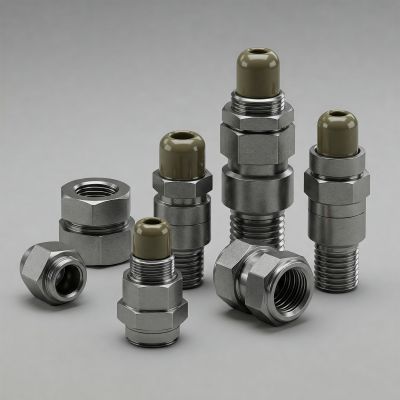Fluid and gas systems play a crucial role in various industries, including automotive, aerospace, and manufacturing. These systems rely on secure and leak-free connections to ensure optimal performance and safety. Fittings are essential components that help achieve these secure connections, and among them, flareless compression fittings stand out due to their ease of installation and reliability.
In this guide, we will explore what flareless compression fittings are, their advantages, applications, selection criteria, installation steps, common issues, and maintenance best practices. Whether you are new to fluid and gas systems or looking to improve your understanding, this guide will provide valuable insights.
What Are Flareless Fittings?
Flareless fittings are mechanical fittings designed to connect tubing or piping without the need for flaring the tube ends. They work by using a compression nut and ferrule to create a tight seal around the tubing when tightened.
How They Differ from Flared Fittings
➡️ Flareless fittings do not require tube flaring, simplifying installation.
➡️ Flared fittings require the tube end to be flared, which demands additional tools and preparation.
➡️ Flareless fittings are ideal for high-pressure applications where vibration and stress are concerns.
Key Components
1. Fitting Body – The main structure that connects to the tubing.
2. Ferrule – A metal ring that compresses against the tubing to create a seal.
3. Nut – Tightens the ferrule and fitting body to secure the connection.
Advantages of Flareless Fittings
➡️ No Need for Flaring Tools – Simplifies the installation process.
➡️ Quick and Easy Installation – Reduces labor time and costs.
➡️ Leak-Free Connections – Designed to provide a tight seal.
➡️ Material Compatibility – Available in stainless steel, brass, and other materials.
➡️ High-Pressure and Vibration Resistance – Ensures durability in demanding environments.
Common Applications
Flareless fittings are widely used in:
➡️ Hydraulic and Pneumatic Systems – Ensures efficient fluid transfer in machinery.
➡️ Automotive and Aerospace Industries – Used in fuel lines, braking systems, and hydraulic controls.
➡️ Oil, Gas, and Chemical Processing – Handles high-pressure fluid transmission.
➡️ Industrial Machinery – Supports various mechanical and fluid power applications.
How to Select the Right Flareless Fitting
➡️ Material Selection – Choose stainless steel, brass, or other materials based on environmental conditions.
➡️ Pressure Ratings – Ensure the fitting can handle system pressure.
➡️ Size Compatibility – Match the fitting size to the tubing.
➡️ Standards and Certifications – Look for compliance with ISO, SAE, or other industry standards.
Step-by-Step Installation Guide
Tools Required
➡️ Wrenches
➡️ Deburring tool
➡️ Measuring tape
Installation Steps
1. Prepare the Tubing – Cut and deburr the tubing end.
2. Insert the Tubing – Place it into the fitting body.
3. Assemble the Fitting – Slide the ferrule and nut onto the tubing.
4. Tighten the Nut – Use a wrench to secure the connection.
5. Check for Leaks – Perform a pressure test to ensure a proper seal.
Troubleshooting Common Issues
➡️ Leaks – Check for loose connections and ensure proper tightening.
➡️ Over-Tightening – Can damage the ferrule and reduce sealing effectiveness.
➡️ Material Compatibility – Verify that the fitting material matches the tubing.
➡️ Wear and Tear – Inspect for signs of corrosion or damage and replace as needed.
Maintenance and Best Practices
➡️ Regular Inspection – Check for leaks and wear.
➡️ Proper Storage – Store fittings in a clean, dry environment.
➡️ Longevity Tips – Avoid over-tightening and follow manufacturer guidelines.
Conclusion
Flareless fittings provide a reliable, easy-to-install solution for fluid and gas systems across multiple industries. Selecting the right fittings, following proper installation techniques, and conducting regular maintenance can ensure long-lasting performance and safety.
By understanding the fundamentals outlined in this guide, you can confidently incorporate flareless compression fittings into your systems for optimal efficiency.
Post time: Apr-08-2025


